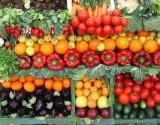Main Menu
Pesticide Residues in Food
Much of the food we eat contains harmful pesticides. It’s not just on the surface of fruits and vegetables when crops have been sprayed: it enters the leaves and affects the molecular construction of the fruit or vegetables. It’s also very hard to remove pesticide residue from the skins of fruits and veggies, even if you wash them thoroughly.
The Environmental Working Group has come up with two lists: the Dirty Dozen, which are the 12 fruits and vegetables with the highest levels of pesticide contamination, and the Clean 15, which are the 15 fruits and veggies with the least amount of pesticides. The current Dirty Dozen list includes: apples, celery, strawberries, peaches, spinach, imported nectarines, imported grapes, sweet bell peppers, potatoes, domestically produced blueberries, kale or collard greens, and lettuce. The Clean 15 is as follows: avocado, asparagus, sweet peas, mangoes, eggplant, domestically produced eggplant and cantaloupe, kiwis, cabbage, watermelon, sweet potatoes, grapefruit, and mushrooms. If you’re buying fruits and vegetables on the Dirty Dozen list, minimize your exposure to pesticides by buying organic whenever you can.
Meat also contains pesticides, because livestock may eat crops that have been sprayed with these chemicals. They may also come in contact with pesticides through drift after spraying. The more fatty the meat, the more pesticide residue it will have. Lean meat like chicken breast has much less residue than chicken thighs, which have one of the highest amounts of residue among meats. Pork also has high pesticide levels.
Pesticide residue in food isn’t just harmful to our bodies – it’s harmful to our food supply. The honeybee population is dwindling, and this is in part due to pesticide use. Because many fruit and vegetable crops rely on pollination, fewer honeybees means less food – in fact, up to 30% of the US food supply could be in danger. Foods at risk include apples, oranges, grapes, watermelon and cucumbers. Grass-fed beef is also in danger: alfalfa is often part of a grass-fed cow’s diet, and despite it not being grass per se, it’s OK to refer to a cow who eats some alfalfa as grass-fed. Alfalfa is a pollinated crop: therefore, the demise of the honeybee will take away the cows’ food supply.
This information is solely for informational and educational purposes only. The publication of this information does not constitute the practice of medicine, family planning, child psychology, marriage counseling and this information does not replace the advice of your physician or other health care or mental health care provider. Neither the owners or employees of NaturalFamilyOnline.com or the author(s) of site content take responsibility for any possible consequences from any treatment, procedure, exercise, dietary modification, application of medication or any other action involving the care of yourself or any family members which results from reading this site. It is always best to speak with your primary health care provider before engaging in any form of self treatment. Additional information contained in our Legal Statement


